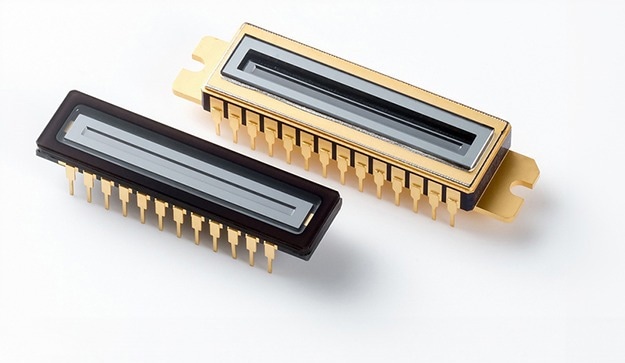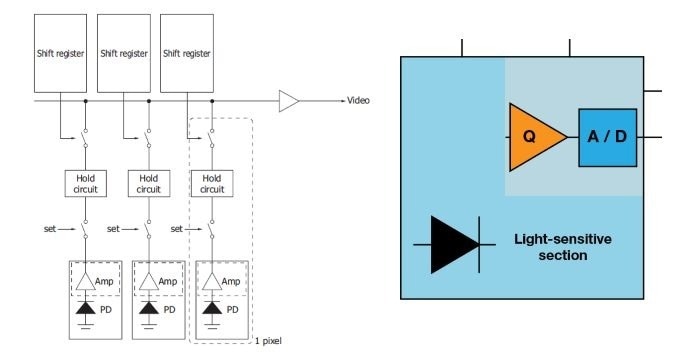Spectroscopy examines how matter interacts with electromagnetic radiation, revealing its composition, structure, and physical properties. This vital technique is widely utilized in chemistry, physics, astronomy, and biology, with applications ranging from water analysis and chemical composition identification to the study of celestial objects.

Image Credit: Hamamatsu Photonics Europe
The image sensor is an essential component of spectroscopy equipment and techniques such as Raman spectroscopy, with CMOS sensors gaining popularity due to its ease of integration, high sensitivity, and ability to acquire data at fast speeds. This has made the CMOS image sensor increasingly popular in spectroscopy.
Introduction to CMOS Image Sensors
An image sensor is a device that captures light and converts it into digital signals, which can then be processed, stored, and reproduced as an image. It typically includes a pixel array that converts photons into electrical signals, a sensing node to amplify the resulting charge, and a converter that translates analog signals into digital form. The charge is transferred to the sensing node through the serial register.
CMOS (Complementary Metal-Oxide-Semiconductor) technology is a widely used type of image sensor that integrates both digital and analog circuits on a single chip. In this design, each pixel contains its own transistor and amplifier, allowing it to independently convert light into an electrical signal. This architecture offers higher integration and improved power efficiency.
The schematic of the CMOS structure is shown in Figure 1.

Figure 1. Typical CMOS structure: The light sensitive part (photodiode) and charge amplifier are integrated into each pixel. Image Credit: Hamamatsu Photonics Europe
CMOS Sensors in Spectroscopy
The unique structure of CMOS technology offers distinct advantages that are highly valued in spectroscopy, including high sensitivity and fast data acquisition. These qualities enable CMOS sensors to detect the faint signals often encountered in spectroscopic analysis and support their use in real-time spectroscopy applications.
Sustainability and advances in on-chip technologies are also driving the rapid growth of CMOS sensor use in spectroscopy. Compared to other sensor types, CMOS sensors are more energy-efficient and offer easier integration, making them well-suited to evolving application needs. Additionally, the cost-effective manufacturing processes behind CMOS technology help make CMOS-based spectroscopic devices more accessible and affordable.
Applications Using Hamamatsu's CMOS Image Sensors
Hamamatsu Photonics is a leading supplier of high-quality, high-performance, and cost-effective CMOS technology, tailored for the industrial, analytical, and spectroscopy markets. With deep expertise across photonics technologies—including optics, electronics, mechanics, and software—the company offers a broad and versatile product portfolio.
Spectroscopy instruments using CMOS image sensors have become essential in a wide range of applications. One of the most recognized uses is in Raman spectroscopy, which plays a key role in medical diagnostics by identifying biomarkers. Other common applications include spectrometers used for monitoring water quality, analyzing food composition, and overseeing manufacturing processes.
CMOS sensors designed specifically for spectroscopy and high-speed, in-line scanning are readily available. Additionally, Hamamatsu Photonics offers customization options to meet specific application requirements.
Monitoring Water Quality
UV-Vis spectroscopy is a reliable and efficient method for online water analysis and real-time monitoring of water quality. It uses spectral remote sensing within the UV and visible wavelengths.
The principle behind UV-Vis spectrophotometry is the correlation between a substance’s concentration and its absorption of specific light wavelengths. With built-in software for particle compensation, this method generally eliminates the need for sample filtration.
It’s reagent-free and delivers rapid, accurate measurements, making it increasingly popular for quick water quality assessments.
Industrial Processes – Position Detection
Hamamatsu has developed a range of photosensors and light emitters used for distance measurement, including in AGVs (Automated Guided Vehicles). AGVs use lasers, optical sensors, MEMS mirrors, and other devices to measure their surroundings and navigate safely without colliding with obstacles or people.
CMOS linear image sensors, known for being compact, lightweight, and cost-effective, are used in triangulation-based systems for precise position detection and object measurement.
Food Inspection
For UV-Vis imaging in food inspection, we offer a selection of CMOS image sensors in both linear and area array formats. Advances in CMOS technology have simplified integration—these sensors incorporate all necessary signal processing circuits on the chip, requiring only basic input pulses and a single power supply.
Key Features Include:
- High sensitivity from UV to near-infrared (up to 1100 nm)
- Wide variety of pixel counts (from 128 to 4096 pixels) and line speeds
- Available in various array sizes, from 30 × 30 pixels to 1280 × 1024 pixels
- Designed for integration into cameras, CMOS area arrays provide wide spectral imaging from UV to NIR
CMOS sensors designed for spectroscopy and high-speed, in-line scanning are available. Custom solutions can also be developed to meet specific needs.

This information has been sourced, reviewed and adapted from materials provided by Hamamatsu Photonics Europe.
For more information on this source, please visit Hamamatsu Photonics Europe.